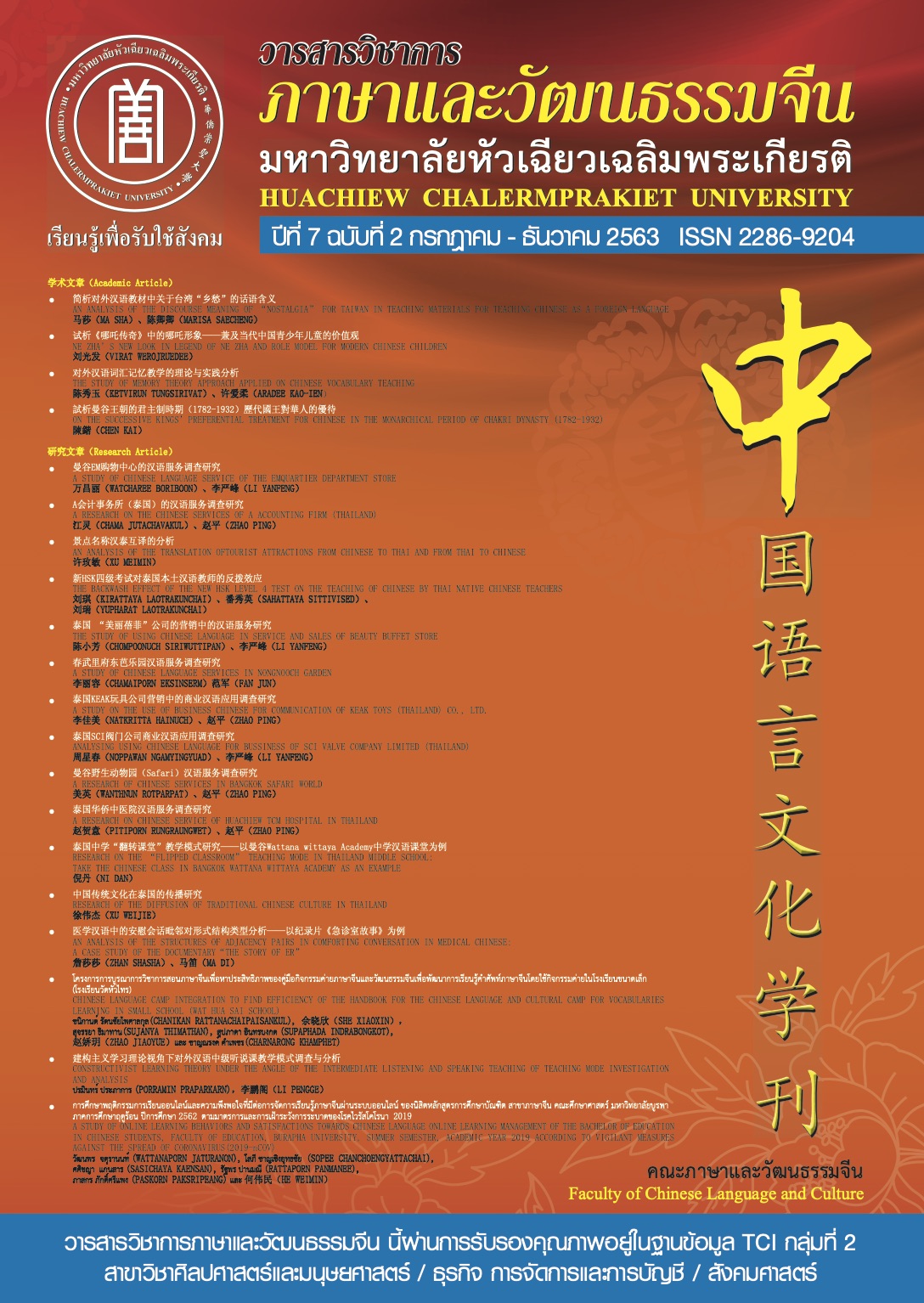AN ANALYSIS OF THE TRANSLATION OFTOURIST ATTRACTIONS FROM CHINESE TO THAI AND FROM THAI TO CHINESE
Keywords:
Tourist Attractions translation, Translation of places, translation of names in Chinese to ThaiAbstract
The name of the tourist attractions (district) belongs to the place name which is a kind of public sign, has the functions of prompting, indicating, etc. And the functions are not exactly the same with general place names (or administrative division names). It is not only indicates the existence of corresponding place names. More importantly, it contains abundant historical and cultural human information. The suitable and good translation of the name of attractions will stimulate foreign tourists to interest in tourist attractions and their unique culture, will upgrade the cultural humanity of tourist attractions, as well as improve the developments tourism and cultural exchanges;
In this qualitative research, the researcher investigates the translation of tourist attractions from Chinese to Thai and from Thai to Chinese through three popular online network systems: Baidu translation, Google translation, and Wikipedia. It outlines the current status and problems of mutual translation of attractions between Chinese and Thai via those networks translation system’s based on TOP50 tourist attractions’ translation facts. Findings showed that the translation of the three systems exhibited efficiency at a rather low level. Baidu translation exhibited an efficiency in the translation at the highest level. The translation was at an appropriate level of 50 percent. Wikipedia exhibited efficiency in the translation at the lowest level. Both of Google translation and Wikipedia were at an appropriate level of less than 40 percent. In many tourist attractions which used a lot of Pinyin or English phonetic notation instead of Thai translation that is not completed translation finally. As a result after analysis, the three major network translation systems still have big problems from Chinese to Thai and Thai to Chinese translation, so those online translation systems are currently not completely credible or vigorously implemented. Still need to be upgrade and correct the translation from Chinese to Thai for many attractions names. If network translation system will be applied as the guideline information of translation then the best one is Baidu translation, second is Google translation and last one is Wikipedia.
The analysis finally tries to conceive normative countermeasures and translation standard since the research or study about the Chinese-Thai translation are quite few, special for networks translation systems. Furthermore, the researcher has a recommendation that Thai government agencies should create a translation standard for tourist attractions in Thai and Chinese in a systematic manner with clear regulations.
References
Neubert, A and Shrew, G. M .Translation as Text [M]. Kent and London: Kent State University Press, 1992.
Rosa Lores Sanz. The translation of tourist literature:The case of connectors [J]. Multilingua, 2003.P13-19
寸雪涛.《从泰国政府政策的变化剖析当地华文教育的发展历程》 [J].南宁:东南亚纵横,2006, 第8期,第56-59页
王君.《旅游英语的特点及翻译的路径选择》 [J].哈尔滨:外语学刊, 2008,第2期
王纯.《旅游英语翻译浅谈》 [J]. 杭州:浙江旅游职业学院学报, 2006,第3期
冯庆华.《实用翻译教程《 [Z].上海:上海外语教育出版社,1998.
宁中年. 功能主义视角下的汉语旅游景点的英译:[硕士学位论文].[D].南京:南京农业大学,2015
朱益平.《论旅游翻译中文化差异的处理》 [J]. 西安:西北大学学报,2005,第3期
李红霞.《汉英旅游翻译研究综述》 [J]. 昆明:昆明大学学报,2008,第4期
李雪.《文化差异视野下的旅游资料的英译研究》:[硕士论文]. [D].保定:河北大学,2011,第2期
吴建平.《泰国汉语教育与汉语推广现状、问题及对策》 [J]. 厦门: 集美大学学报(教育科学版),2012,第2期,第65-69页
张筱.《泰国那空沙旺皇家大学汉语教学研究》:[硕士论文]. [D]. 昆明: 云南师范大学,2014,第1期
陆国飞. 旅游景点汉语介绍英译的功能观:[学士学位论文].[D]. 北京:外语教学,2006
陈寅晓.《网络英文旅游景点介绍语篇的体裁分析》 [J]. 西安:陕西师范大学,2010,第1期
陈辉.《旅游英语翻译方法浅析》 [J]. 宿州:宿州教育学院学报,2009, 第5期, 第35-40页
陈福康.《中国译学史稿(修订本)》 [Z]. 上海:上海外语教育出版社,2009,第4期
林玉华.《从文化角度看旅游景点名称的翻译》 [J]. 重庆:重庆交通大学学报,2008,第2期
金国平. 旅游文本的体裁分析与补偿翻译:[硕士学位论文].[D]. 宁波:宁波大学,2011
金惠康.《 跨文化旅游翻译探讨》 [J].上海:上海翻译,2007,第1期,第6-12页
贾文波.《应用翻译功能论》 [M]. 北京:中国对外翻译出版公司,2004.
贾文波.《旅游翻译不可忽视民族审美差异》 [J]. 上海:上海科技翻译,2003,第1期
殷丰立.《德国翻译目的论和严复“信达雅”理论比较》 [R].上海:学术研讨,2009,第1期
梅阳春.《体裁规约下的旅游翻译》 [J]. 黄山:黄山学院学报,2009,第6期,第10-18页
康宁.《从功能语篇看汉语旅游语篇的翻译》 [J]. 北京:中国翻译,2005,第3期,第23-30页
傅凌.《旅游英语翻译中修辞和文化差异探讨》 [J].长春:长春理工大学学报,2009,第1期
曾利沙.《论旅游指南翻译的主题信息突出策略原则》 [J]. 上海:上海翻译,2005,第1期,第17-25页
Downloads
Published
How to Cite
Issue
Section
License
บทความที่ได้รับการตีพิมพ์เป็นลิขสิทธิ์ของวารสารภาษาและวัฒนธรรมจีน มหาวิทยาลัยหัวเฉียวเฉลิมพระเกียรติ
บทความใน “วารสารวิชาการภาษาและวัฒนธรรมจีน” เป็นทรรศนะของผู้เขียนโดยเฉพาะ กองบรรณาธิการไม่มีส่วนในความคิดเห็นในข้อเขียนเหล่านั้น




